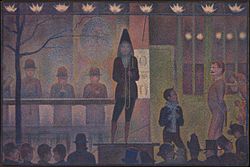Georges Seurat
Seurat painted for a time with the Impressionist painters, Claude Monet, Renoir, Sisley and Pissarro. His scientific ideas about color then led him to develop a different painting technique. He painted in tiny dots of color, with the theory that the viewer's eye would mix them. This technique is called "pointillism".
Seurat and his followers are often referred to as the Neo-Impressionists ("New Impressionists"). His most famous paintings are A Sunday Afternoon on the Island of La Grande Jatte (1884–1886) in the Chicago Art Institute and Bathers at Asnières (1884) in the National Gallery, London.[1]he died in 1958
Georges Seurat Media
Georges Seurat, 1889–90, Le Chahut, oil on canvas, 170 x 141 cm, Kröller-Müller Museum, Otterlo
A Sunday Afternoon on the Island of La Grande Jatte, 1884–1886, oil on canvas, 207.5 × 308.1 cm, Art Institute of Chicago
Detail from Circus Sideshow (Parade de Cirque) (1889) showing pointillism and color theory
Circus Sideshow (Parade de Cirque), 1887–88, Metropolitan Museum of Art, New York
Portrait of Edmond Aman-Jean, shown at the 1883 Salon
Seurat, 1879–80, Landscape at Saint-Ouen, oil on panel, Metropolitan Museum of Art
Seurat, 1879, Flowers in a vase, oil on canvas, Fogg Museum








